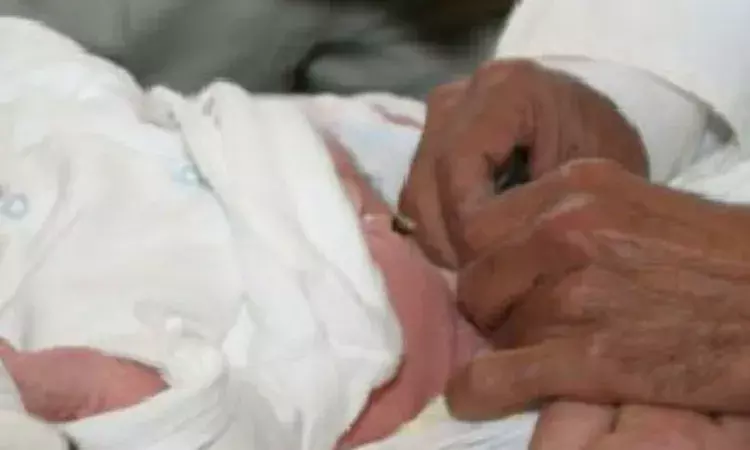- Home
- Medical news & Guidelines
- Anesthesiology
- Cardiology and CTVS
- Critical Care
- Dentistry
- Dermatology
- Diabetes and Endocrinology
- ENT
- Gastroenterology
- Medicine
- Nephrology
- Neurology
- Obstretics-Gynaecology
- Oncology
- Ophthalmology
- Orthopaedics
- Pediatrics-Neonatology
- Psychiatry
- Pulmonology
- Radiology
- Surgery
- Urology
- Laboratory Medicine
- Diet
- Nursing
- Paramedical
- Physiotherapy
- Health news
- Fact Check
- Bone Health Fact Check
- Brain Health Fact Check
- Cancer Related Fact Check
- Child Care Fact Check
- Dental and oral health fact check
- Diabetes and metabolic health fact check
- Diet and Nutrition Fact Check
- Eye and ENT Care Fact Check
- Fitness fact check
- Gut health fact check
- Heart health fact check
- Kidney health fact check
- Medical education fact check
- Men's health fact check
- Respiratory fact check
- Skin and hair care fact check
- Vaccine and Immunization fact check
- Women's health fact check
- AYUSH
- State News
- Andaman and Nicobar Islands
- Andhra Pradesh
- Arunachal Pradesh
- Assam
- Bihar
- Chandigarh
- Chattisgarh
- Dadra and Nagar Haveli
- Daman and Diu
- Delhi
- Goa
- Gujarat
- Haryana
- Himachal Pradesh
- Jammu & Kashmir
- Jharkhand
- Karnataka
- Kerala
- Ladakh
- Lakshadweep
- Madhya Pradesh
- Maharashtra
- Manipur
- Meghalaya
- Mizoram
- Nagaland
- Odisha
- Puducherry
- Punjab
- Rajasthan
- Sikkim
- Tamil Nadu
- Telangana
- Tripura
- Uttar Pradesh
- Uttrakhand
- West Bengal
- Medical Education
- Industry
Circumcision lowers UTI risk in children with antenatal hydronephrosis

A new study found that circumcision was associated with a decreased incidence of UTI in children with antenatal hydronephrosis (ANH). The mechanism by which circumcision reduces UTI is most likely due to a reduction in bacterial contamination. The study results were published in the Journal of Pediatric Urology.
Urinary tract infection (UTI) is more common in boys with antenatal hydronephrosis. Circumcision is a common procedure that is done to lessen the risk of UTI. The American Academy of Pediatrics (AAP) consensus statement on male circumcision also recommends circumcision for boys with urological anomalies to reduce UTI incidence. As there was no meta-analysis investigating the correlations between circumcision and UTI in boys with ANH, researchers conducted a systematic review and meta-analysis to review the currently available data.
Following the Preferred Reporting Items for Systematic Reviews and Meta-Analyses standards, this systematic review and meta-analysis were performed. Eligible studies were identified by searching databases like PubMed, ScienceDirect, EMBASE, and Cochrane Library through August 4th, 2022. Newcastle-Ottawa Scale (NOS) was used to measure the risk of bias. Review manager 5.4 was used for all analyses.
Results
- A total of 21 studies involving 8,968 patients with ANH were included in the meta-analysis.
- The uncircumcised group showed an incidence of 18.1% of UTI while circumscribed group showed 4.9% of UTI.
- Circumcision had a significant protective effect against UTI with pooled OR of 0.28 as noticed from the analysis (95% CI 0.23–0.32).
- Significant protective effects were also found in a subgroup analysis of hydronephrosis etiology, including vesicoureteral reflux, obstructive hydronephrosis, and posterior urethral valve.
Thus, circumcision appears to be a successful, very straightforward, and inexpensive treatment for patients with ANH to reduce UTI.
TAKE-HOME MESSAGE
- The authors performed a meta-analysis to determine the association between circumcision and urinary tract infections (UTIs) in boys with antenatal hydronephrosis. They found that circumcision had a significant protective effect against UTIs in boys with antenatal hydronephrosis, regardless of the etiology of hydronephrosis.
- For boys with antenatal hydronephrosis, circumcision should be discussed with parents as a method to reduce the risk of UTIs in this population.
Further reading: Wahyudi I, Raharja PAR, Situmorang GR, Rodjani A. Circumcision reduces urinary tract infection in children with antenatal hydronephrosis: Systematic review and meta-analysis [published online ahead of print, 2022 Oct 28]. J Pediatr Urol. 2022;S1477-5131(22)00471-5. doi:10.1016/j.jpurol.2022.10.029
BDS, MDS
Dr.Niharika Harsha B (BDS,MDS) completed her BDS from Govt Dental College, Hyderabad and MDS from Dr.NTR University of health sciences(Now Kaloji Rao University). She has 4 years of private dental practice and worked for 2 years as Consultant Oral Radiologist at a Dental Imaging Centre in Hyderabad. She worked as Research Assistant and scientific writer in the development of Oral Anti cancer screening device with her seniors. She has a deep intriguing wish in writing highly engaging, captivating and informative medical content for a wider audience. She can be contacted at editorial@medicaldialogues.in.
Dr Kamal Kant Kohli-MBBS, DTCD- a chest specialist with more than 30 years of practice and a flair for writing clinical articles, Dr Kamal Kant Kohli joined Medical Dialogues as a Chief Editor of Medical News. Besides writing articles, as an editor, he proofreads and verifies all the medical content published on Medical Dialogues including those coming from journals, studies,medical conferences,guidelines etc. Email: drkohli@medicaldialogues.in. Contact no. 011-43720751




